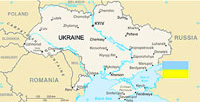RIA Novosti: Parties at Minsk Talks Agree on Memorandum Regulating Ukrainian Ceasefire Implementation

MINSK, September 20 (RIA Novosti) – Kiev authorities and pro-independence fighters in southeastern Ukraine have agreed on complete ceasefire, establishment of the buffer zone, withdrawal of heavy weapons away from the contact line on both sides, and deployment of the Organization for Security and Cooperation in Europe (OSCE) monitoring mission.
Early Saturday morning parties at the talks in Minsk – Russia, Ukraine, the self-proclaimed Donetsk and Luhansk People’s republics and the Organization for Security and Co-operation in Europe (OSCE) – aligned positions and formulated a memorandum of nine provisions that will regulate the implementation of a ceasefire agreement between Kiev and independence supporters in eastern Ukraine. Leonid Kuchma, former Ukrainian president representing the country at the talks, read out the provisions of the memorandum at the conclusion of the talks.
MINSK MEMORANDUM
1. Ceasefire is to be considered bilateral.
2. Military elements and military formations shall be stopped at their contact line as of September 19.
3. Usage of all kinds of weapons and offensive actions are prohibited.
4. Within 24 hours after the approval of this memorandum weapons with a calibre of more than 100 millimeters shall be moved at least 15 kilometers away from the contact line on both sides, including from the residential areas, which would create an opportunity to establish a 30-kilometers buffer zone.
5. Deployment of heavy weapons and heavy equipment in the region confined by the residential areas [Kuchma did not specify which areas are listed in the memorandum] is prohibited.
6. Placing of mine barriers at the border of the buffer zone is prohibited. Mine barriers that were placed earlier within the buffer zone shall be removed.
7. Flights of operational aircrafts and foreign aerial vehicles except for the vehicles of the OSCE over the buffer zone are prohibited.
8. In the ceasefire zone the OSCE monitoring mission, consisting of the group of the organization’s observers shall be deployed within 24 hours after the approval of this memorandum. It is desirable that the above mentioned zone shall be divided into sectors. The number of the sectors’ borders shall be negotiated in the course of the preparation to the work of the OSCE monitoring mission’s group of observers.
9. All the foreign armed groups, military equipment, as well as fighters and mercenaries shall withdraw from the Ukrainian territory under the supervision of the OSCE.
MINSK PROTOCOL
Minsk protocol, signed by the Trilateral negotiation group on September 5, addresses more issues and consists of 12 provisions. The protocol envisages a ceasefire and suggests, among other things, that Ukraine should adopt a law on granting special status to the Donetsk and Luhansk regions and early elections of the heads of the self-proclaimed Donetsk and Luhansk republics. The document also stipulates that the consent of the Luhansk and Donetsk People’s Republics with regard to the adoption of the law would not mean abandonment of their independence. The leaders of the self-defense forces also declared that they lay claim to all of the territories in the Donetsk and Luhansk regions and would not consent to the “special status” only for the parts of the territories under their control.
LAW ON SPECIAL STATUS
September 16 Ukraine’s parliament, the Verkhovna Rada, approved a law on special status of parts of the Donetsk and Luhansk regions, submitted by President Petro Poroshenko. The law introduces self-administration, states that local elections are to take place in the regions on December 7 and guarantees the right to use Russian or any other language in Ukraine.
The law envisages that the local authorities would be able to make agreements with the central state bodies on economic, social and cultural development.
Moreover, these regions will be granted a special economic status, which will help to restore industry and infrastructure, as well as attract investments and create jobs.
The Contact Group on the Ukrainian crisis, comprising officials from Russia, Ukraine, the self-proclaimed Donetsk and Luhansk People’s republics and the Organization for Security and Co-operation in Europe, began a new round of talks in Belorussian capital, Minsk, on Friday.
The agenda of the talks mainly focused on the discussion of a document that would regulate the implementation of a ceasefire agreement between Kiev and independence supporters in eastern Ukraine, reached on September 5.
The meeting of the group on September 5 resulted in a fragile ceasefire between Kiev and independence supporters in eastern Ukraine.
The five-months conflict has already killed over 3,000 people and wreaked havoc on Ukraine’s economy, also leading to the biggest confrontation between Russia and the West since the Cold War.
